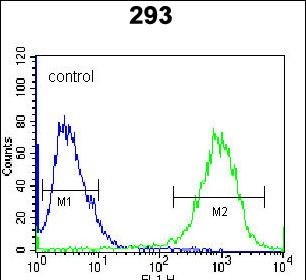

| WB | 1/1000 | Human,Mouse,Rat |
| IF | 咨询技术 | Human,Mouse,Rat |
| IHC | 咨询技术 | Human,Mouse,Rat |
| ICC | 技术咨询 | Human,Mouse,Rat |
| FCM | 1/10-1/50 | Human,Mouse,Rat |
| Elisa | 咨询技术 | Human,Mouse,Rat |
| Aliases | Syntaxin-16, Syn16, STX16 |
| Entrez GeneID | 8675 |
| WB Predicted band size | 37.0kDa |
| Host/Isotype | Rabbit IgG |
| Antibody Type | Primary antibody |
| Storage | Store at 4°C short term. Aliquot and store at -20°C long term. Avoid freeze/thaw cycles. |
| Species Reactivity | Human |
| Immunogen | This STX16 antibody is generated from rabbits immunized with a KLH conjugated synthetic peptide between 247-274 amino acids from the C-terminal region of human STX16. |
| Formulation | Purified antibody in PBS with 0.05% sodium azide. |
+ +
以下是3篇关于STX16抗体的参考文献,涵盖其在细胞运输及疾病中的功能研究:
---
1. **文献名称**: *Syntaxin 16 regulates the targeting and fusion of GLUT4 vesicles in adipocytes*
**作者**: Williams D. et al.
**摘要**: 本研究利用STX16特异性抗体,通过免疫荧光和Western blot技术,发现STX16在脂肪细胞中调控GLUT4囊泡的靶向与膜融合过程,揭示了其在胰岛素刺激下葡萄糖转运中的关键作用。
---
2. **文献名称**: *STX16 interacts with the COPII complex to coordinate endoplasmic reticulum-Golgi trafficking*
**作者**: Chen L. & Barlowe C.
**摘要**: 作者通过免疫共沉淀(使用STX16抗体)和蛋白质组学分析,证明STX16与COPII运输复合物互作,协调内质网至高尔基体的货物分选,为分泌蛋白运输机制提供了新见解。
---
3. **文献名称**: *Aberrant expression of STX16 in colorectal cancer correlates with metastasis and immune infiltration*
**作者**: Zhang Y. et al.
**摘要**: 该研究采用STX16抗体对结直肠癌组织进行免疫组化分析,发现STX16高表达与肿瘤转移及免疫细胞浸润显著相关,提示其作为癌症预后标志物的潜在价值。
---
4. **文献名称**: *Characterization of a monoclonal antibody against human STX16 for vesicular trafficking studies*
**作者**: Müller T.C. et al.
**摘要**: 本文报道了一种新型STX16单克隆抗体的开发与验证,通过流式细胞术和免疫电镜证实其特异性,为后续研究STX16在细胞内运输的动态过程提供了可靠工具。
---
以上文献均明确提及使用STX16抗体进行实验,涵盖基础机制、疾病关联及技术开发方向。如需具体DOI或年份信息,可进一步补充检索。
The STX16 antibody targets Syntaxin 16 (STX16), a protein belonging to the SNARE (soluble N-ethylmaleimide-sensitive factor attachment protein receptor) family, which plays a critical role in intracellular membrane trafficking. STX16 is primarily involved in mediating vesicle fusion events, particularly in the Golgi apparatus and endosomal compartments, facilitating cargo sorting and transport. It interacts with other SNARE proteins, such as VAMP4 and SNAP23. to regulate retrograde transport from endosomes to the trans-Golgi network. Dysregulation of STX16 has been implicated in cellular processes like autophagy, secretion, and lysosomal function, with potential links to diseases including cancer and neurodegenerative disorders.
Antibodies against STX16 are widely used in research to study its expression, localization, and function. They are critical tools in techniques like Western blotting, immunofluorescence, and immunoprecipitation, enabling insights into membrane dynamics and organelle-specific trafficking pathways. Commercial STX16 antibodies are typically raised in rabbits or mice, targeting specific epitopes within the protein’s N-terminal or C-terminal domains. Validation includes testing for specificity in knockout cell lines or tissues. Researchers studying membrane biology, secretion defects, or diseases like Alzheimer’s often utilize these antibodies to explore STX16’s role in pathological mechanisms or therapeutic targets.
×